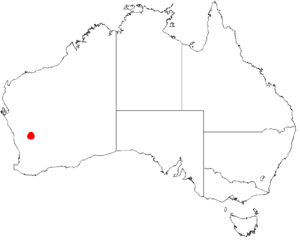Gibson wattle facts for kids
Quick facts for kids Gibson wattle |
|
|---|---|
| Conservation status | |
| Scientific classification | |
| Genus: |
Acacia
|
| Species: |
imitans
|
 |
|
| Occurrence data from AVH | |
The Gibson Wattle (scientific name: Acacia imitans) is a special type of shrub found only in southwestern Australia. It's part of the Acacia family, which includes many types of wattle trees. Sadly, this plant is considered endangered by both Australian laws and a global list called the IUCN Redlist. This means it's at high risk of disappearing forever.
What the Gibson Wattle Looks Like
The Gibson Wattle is a low, bushy shrub that spreads out. It usually grows about 0.2 to 1.0 metre (0.7 to 3.3 ft) tall and can spread up to 2.0 metres (6.6 ft) wide, creating a thick cover.
Its branches are smooth and grey. Like many other Acacia plants, it doesn't have regular leaves. Instead, it has special flattened stems called phyllodes. These small, uneven phyllodes have a sharp, upward-pointing tip.
The Gibson Wattle blooms from August to September. During this time, it produces bright yellow flowers. These flowers grow in simple, oval-shaped to short, cylinder-shaped clusters. Each flower cluster is about 6 to 8 mm (0.24 to 0.31 in) long and 4 to 5 mm (0.16 to 0.20 in) across.
Where the Gibson Wattle Lives
The Gibson Wattle grows in a very small area near Yalgoo in the Wheatbelt region of Western Australia. It likes rocky hills and red, loamy (clay-like) soils. You can often find it growing among other tall shrubs.
There are only six small groups of these plants, called subpopulations, known to exist. Four of these groups are found near Ningham Station, and two are at Mount Gibson Station. These areas are about 300 km (190 mi) northeast of Perth. Scientists estimate there are only about 550 mature Gibson Wattle plants left in total.
Why the Gibson Wattle is in Danger
The Gibson Wattle lives in a very small space, covering only about 30 to 100 square kilometers. This makes it very vulnerable to different threats:
- Grazing Animals: Sheep and wild goats eat the plants, which can stop them from growing and reproducing.
- Fires: The wrong kind of fires, either too often or not often enough, can harm the plants and their habitat.
- Mining: There's a possibility of mining in the area, which could destroy where the plants live.
- Climate Change: Changes in weather patterns, like less rain or hotter temperatures, can also make it harder for the Gibson Wattle to survive.


